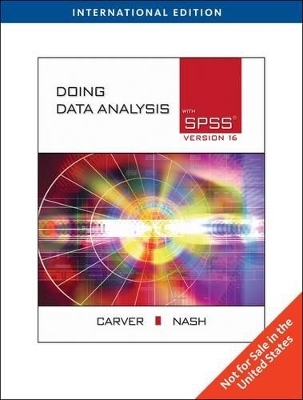
Doing Data Analysis with SPSS(r
Brooks/Cole
978-0-538-73426-4 (ISBN)
- Titel ist leider vergriffen;
keine Neuauflage - Artikel merken
DOING DATA ANALYSIS WITH SPSS VERSION 14.0, International Edition (WITH CD-ROM) is the perfect supplement to help you succeed in your statistic course! This innovative guide offers practical instruction to SPSS 14.0, helping you learn helpful software skills. By using SPSS to handle complex computations, you can focus on the underlying statistical concepts and techniques in the introductory statistics course.
SESSION 1. A FIRST LOOK AT SPSS 16.0. Objectives. Launching SPSS. Entering Data into the Data Editor. Saving a Data File. Creating a Bar Chart. Saving an Output File. Getting Help. Printing in SPSS. Quitting SPSS. SESSION 2. TABLES AND GRAPHS FOR ONE VARIABLE. Objectives. Opening a Data File. Exploring the Data. Creating a Histogram . Frequency Distributions. Another Bar Chart. Printing Session Output. Moving On. SESSION 3. TABLES AND GRAPHS FOR TWO VARIABLES. Objectives. Cross-Tabulating Data. Editing a Recent Dialog. More on Bar Charts. Comparing Two Distributions. Scatterplots to Detect Relationships. Moving On... SESSION 4. ONE-VARIABLE DESCRIPTIVE STATISTICS. Objectives. Computing One Summary Measure for a Variable. Computing Additional Summary Measures. A Box-and-Whiskers Plot. Standardizing a Variable. Moving On. SESSION 5. TWO-VARIABLE DESCRIPTIVE STATISTICS. Objectives. Comparing Dispersion with the Coefficient of Variation. Descriptive Measures for Subsamples. Measures of Association: Covariance and Correlation. Moving On. SESSION 6. ELEMENTARY PROBABILITY. Objectives. Simulation. A Classical Example. Observed Relative Frequency as Probability. Handling Alphanumeric Data. Moving On. SESSION 7. DISCRETE PROBABILITY DISTRIBUTIONS. Objectives. An Empirical Discrete Distribution. Graphing a Distribution. A Theoretical Distribution: The Binomial. Another Theoretical Distribution: The Poisson. Moving On. SESSION 8. NORMAL DENSITY FUNCTIO.S. Objectives. Continuous Random Variables. Generating Normal Distributions. Finding Areas under a Normal Curve Normal Curves as Models. Moving On. SESSION 9. SAMPLING DISTRIBUTIONS. Objectives. What Is a Sampling Distribution? Sampling from a Normal Population. Central Limit Theorem. Sampling Distribution of the Proportion. Moving On. SESSION 10. CONFIDENCE INTERVALS Objectives. The Concept of a Confidence Interval. Effect of Confidence Coefficient. Large Samples from a Non-normal (Known) Population. Dealing with Real Data. Small Samples from a Normal Population. Moving On. SESSION 11. ONE-SAMPLE HYPOTHESIS TESTS. Objectives. The Logic of Hypothesis Testing. An Artificial Example. A More Realistic Case: We Don't Know Mu or Sigma. A Small-Sample Example. Moving On. SESSION 12. TWO-SAMPLE HYPOTHESIS TESTS. Objectives. Working with Two Samples. Paired vs. Independent Samples. Moving On. SESSION 13. ANALYSIS OF VARIANCE (I). Objectives. Comparing Three or More Means. One-Factor Independent Measures ANOVA. Where Are the Differences? One-Factor Repeated Measures ANOVA Where Are the Differences? Moving On. SESSION 14. ANALYSIS OF VARIANCE (II). Objectives. Two-Factor Independent Measures ANOVA. Another Example. One Last Note. Moving On. SESSION 15. LINEAR REGRESSION (I). Objectives. Linear Relationships. Another Example. Statistical Inferences in Linear Regression. An Example of a Questionable Relationship. An Estimation Application. A Classic Example. Moving On. SESSION 16. LINEAR REGRESSION (II). Objectives. Assumptions for Least Squares Regression. Examining Residuals to Check Assumptions. A Time Series Example. Issues in Forecasting and Prediction. A Caveat about "Mindless" Regression. Moving On. SESSION 17. MULTIPLE REGRESSION. Objectives. Going Beyond a Single Explanatory Variable. Significance Testing and Goodness of Fit. Residual Analysis. Adding More Variables. Another Example. Working with Quaitative Variables. A New Concern. Moving On. SESSION 18. NONLINEAR MODELS. Objectives. When Relationships Are Not Linear. A Simple Example. Some Common Transformations. Another Quadratic Model. A Log-Linear Model. Adding More Variables. Moving On. SESSION 19. BASIC FORECASTING TECHNIQUES. Objectives. Detecting Patterns over Time. Some Illustrative Examples. Forecasting Using Moving Averages. Forecasting Using Trend Analysis. Another Example. Moving On. SESSION 20. CHI-SQUARE TESTS. Objectives. Qualitative vs. Quantitative Data. Chi-Square Goodness-of-Fit Test. Chi-Square Test of Independence. Another Example. Moving On. SESSION 21. NONPARAMETRIC TESTS. Objectives. Nonparametric Methods. Mann-Whitney U Test. Wilcoxon Signed Ranks Test. Kruskal-Wallis H Test. Spearmans Rank Order Correlation. Moving On. SESSION 22. TOOLS FOR QUALITY. Objectives. Processes and Variation. Charting a Process Mean. Charting a Process Range. Another Way to Organize Data. Charting a Process Proportion. Pareto Charts. Moving On. Appendix A. Dataset Descriptions. Appendix B. Working with Files. Objectives. Data Files. Viewer Document Files. Converting Other Data Files into SPSS Data Files. Index.
| Erscheint lt. Verlag | 20.8.2009 |
|---|---|
| Verlagsort | CA |
| Sprache | englisch |
| Maße | 184 x 230 mm |
| Gewicht | 612 g |
| Themenwelt | Mathematik / Informatik ► Mathematik ► Computerprogramme / Computeralgebra |
| Mathematik / Informatik ► Mathematik ► Statistik | |
| ISBN-10 | 0-538-73426-4 / 0538734264 |
| ISBN-13 | 978-0-538-73426-4 / 9780538734264 |
| Zustand | Neuware |
| Haben Sie eine Frage zum Produkt? |